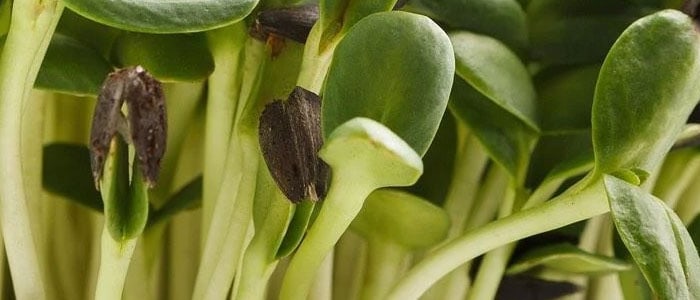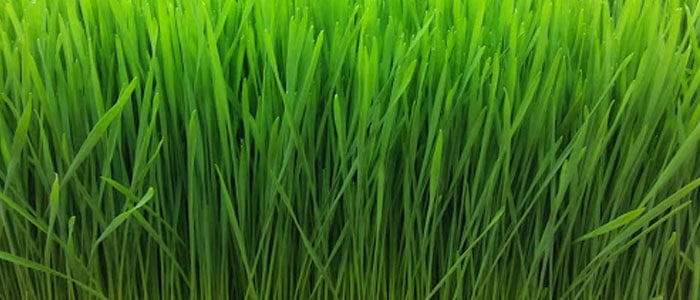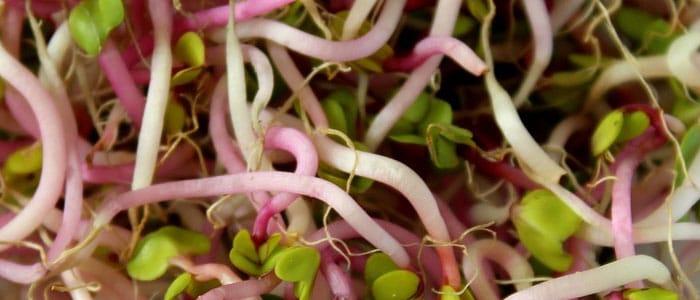What are the healthiest microgreens to grow
Microgreens are becoming increasingly popular in the market because they are super healthy. Chefs and home users all over have taken to incorporating them in their salads, smoothies, soups, and sandwiches because of the tons of nutrients they contain. So if you would like to know what the healthiest microgreens to grow, we’ve made a great list bellow for you.
What we love about them is they are easy to grow right from the comfort of your house. They also take a considerably short time to germinate and be ready for use.
They come in vibrant colors, which are sure to catch your eye, and their rich flavors are a treat to your taste buds. They are suitable for use as garnishes on different dishes and they never disappoint.
Although all microgreens package macronutrients, some are more health-packed than others. Here are the healthiest microgreens to grow!

Pea shoots
If you are looking for the healthiest microgreens to grow, pea shoots are the first go-to. Pea shoots are fascinating and loaded with nutrients.
They are the simplest to grow. You will go out of the house, and by the time you are getting back, they will have grown a few inches.
These delicate shoots render a crispy feel to whatever dish they are used in. They are also very mild in flavor, but they compensate for the nutritional value.
• Growing Instructions
Pea shoots are very easy to grow even for those with the poorest growing skills. Pea shoots grow very quickly. You could literally grow an inch if you stared at them long enough.
Pea shoots should not be allowed to grow more than 4 inches, which means that you need to keep an eye on them. If allowed to go past three weeks, they could grow to ten inches and develop a woody taste.
They also grow tougher as they grow bigger, and if left for too long, they decrease in palatability. Pea shoots are like cats with nine lives.
They regrow up to 3 times after cutting them off but decrease in nutrients and vibrance with every regrow.
• Nutrition Information
Pea shoots are loaded with macronutrients. They contain vitamins and beta-carotene. Our bodies convert beta-carotene into vitamin A and C, needed for immunity.
They also contain folate, a building block for the human body, and fibers. Pea shoots can be used on a salad because they are crispy and eye-catching.
For the best results, you should leave them in the fridge for a couple of minutes before use to enhance the crispiness. They can also be cooked as a vegetable but avoid overcooking.

Swiss chard sprouts
Swiss chard is a great microgreen that can be used as a component to make salads and to garnish dishes.
Its vibrant color makes it suitable for use on toppings. Swiss chard does not fall short in nutrients as it’s packed with macronutrients needed for your health. It’s a great addition to your list of healthiest microgreens to grow.
• Growing Instructions
Swiss chard, like other microgreens, is very easy to grow. The microgreens require soil as a growing medium.
You can grow them in the comfort of your house, either indoors or outdoors. The seeds of swiss chard should be soaked before being tossed in the soil.
Ensure to drain them thoroughly before putting the seeds in the soil. Also, you do not need a lot of seeds to grow.
For the best results, try covering the growing dish with a black dome for 4-7 days immediately after tossing the seeds.
Germination should occur in no time. Between 2-5 days, you should notice germination takes place. Swiss chards are fast-growing and should be ready for harvest in less than two weeks.
When grown under the best conditions, 8-12 days are the most you should take to harvest. Ensure to cut them at the base to source all the nutrients.
• Nutrition Information
Swiss chards grow in a darker shade of green and they come in a spinach flavor. They are packed with lutein, which is an antioxidant that protects your eyes from damage ad ensures that the skin is healthy and safe from damage. Swiss chards are also high in zeaxanthin, a component that aids the body in fighting against macular degeneration.
Swiss chords are suitable for use in salads as they are very healthy, even in their raw form. These microgreens can also be used as toppings and for garnishes.

Clover Sprouts
Clovers are known for their simply breathtaking signature scent. These microgreens do not disappoint when it comes to nutrition too. They are packed with a bunch of nutrients that your body requires.
We can define clover as an all-rounded microgreen as it packs flavor, nutrients, and is definitely a treat for your nostrils.
• Growing Instructions
Clover micros are extremely fast-growing. Under the right6 conditions, clover will germinate in a day or two at maximum. The clover microgreen should be grown hydroponically, and about one ounce of seed is enough for a 1020 tray.
They also need to be covered in a black dome for between 3-5 days. On the 3rd and 4th day, a black lid should be put over the tray to strengthen the crop before you can fully expose it to natural light. The seeds do not need to be presoaked before planting too.
• Nutrition Information
Clover comes in green leaves and has a mild flavoring with an ever-fresh smell. These microgreens are loaded with minerals such as calcium for strong bones, iron which is great for blood building, magnesium, and zinc. Clover shoots make great garnishes and salads. The crunchy nature makes clover excellent for dressing salads.

Sunflower shoots
Sunflower shoots are healthy microgreens that are very easy to grow. Their aroma will take you on a complete ride between nutty and lemony.
Sunflower shoots add a citrus touch to all salads and meals with their lemony taste and smell.
Microgreens tend to carry a reminiscent flavor of the plant they are eventually going to turn to be, and sunflower shoots are no exception. Consider these ones very special to the healthiest microgreens to grow list.
• Growing Instructions
Sunflower grows and germinates very fast, just like the other microgreens. Sunflower microgreens are not only easy to sprout, but they are also ready for harvesting and eating in less than two weeks.
They do not require any special container for growing, and you can use it close to any that you can find in your home. You can find special dome for this purpose in commercial shops.
For the best results, ensure that seeds completely cover the soil surface, but they should not be stacked on each other. The seeds should be presoaked and drained completely before soaking them in the soil.
You can soak the seeds using hydrogen peroxide and water. The microgreens should be ready for harvesting in 8-12 weeks tops. You can cut them and store them in your fridge for up to 2 weeks.
• Nutrition Information
Although sunflower microgreens appear very small, they are jam-packed with nutrients. They are very delicious and juicy. They feature a mild nutty flavor but with the taste of spinach.
These microgreens are plant proteins meaning they are loaded with all essential amino acids. Although they contain minerals such as calcium and magnesium, they are particularly rich in zinc.
Zinc is utterly important in regulating digestion and boosting the general immunity of the body. As if not enough, sunflower microgreens also present an impressive number of vitamins such as A, B complex, D, and E.
Sunflower microgreens can be used in salads as dressing, sandwiches, and even as garnishes for most dishes. They introduce a crunchy texture to the meal transforming it completely.
The sweet, nutty flavor also makes them a great stand-alone meal. These microgreens are, however, better eaten raw than cooked to avoid reducing the nutrients.

Kale
Kale microgreen makes a great beginner-friendly micro because it’s easy to grow and one of the fastest-growing ones at that. Kale is hard to mess up even for someone with zero knowledge about them. The nutrients it packages also make the time and effort put in planting worth it.
• Growing Instructions
Kale microgreens are also quite easy to grow. They should be scattered on the soil surface to avoid crowding. About one ounce of seeds is enough for a 1020 growing tray.
The soil should be sprinkled lightly on the surface before the seeds are tossed on it. The soil does not need to be logged completely as long as the surface is wet. There is no need to presoak the seeds before planting them either.
The kale seeds should be covered using a blackout dome for 3-5 days. On the 4th and 5th day, the kale should be carefully flipped on a blackout lid to ensure the stalks are strong enough before exposing them to light.
In the proper conditions, the kale should germinate in 2-3 days. Harvesting can be done in 12 days or 14 max.
• Nutrition Information
Kale microgreens to the chart when nutrition is concerned. They come in green color with a flavor that resembles that of red leaf lettuce or romaine. Kale is loaded with antioxidants and superfoods.
It’s also a powerhouse for vitamin C, which is essential for building immunity.
Kale can be bitter, so if that not really what you like but don’t want to miss out on the nutritious microgreen, you can make it part of a salad to subside the bitterness.
Kale is also very rich in lutein, which is an active antioxidant that does magic for your eyes and body. These microgreens can also be used in smoothies but never in a dish alone.

Wheatgrass Sprouts
Wheatgrass is a long-time player in the world of micro. The microgreen is known for its healthy composition and green flavor. For those on a diet or vegans, wheatgrass presents a great option. For others, however, it can be a big turn off because of the taste. Wheatgrass can, however, be used in smoothies if one cannot stand to have them alone.
• Growing Instructions
Wheatgrass is a complete package. From being one of the nutrient-richest micros, it’s also rather easy to grow. Wheatgrass germinates and is ready for harvest in 5-10 days in the right growing conditions.
Also, when the microgreen is ready, you can use it in making juices or store the rest in the freezer if you cannot use it all in a single sitting. Wheatgrass is, however, best when fresh and straight from harvesting.
• Nutrition Information
Who can say no to a load of nutrients, especially when it comes in such tiny bundles? Wheatgrass is bursting with several vitamins, which are good news for your body. This is why it made it to the healthiest microgreens to grow list.
The microgreen contains vitamins A, B complex, D, and E. Also, it contains a handful of minerals such as zinc, potassium, phosphorus, calcium for strong bones, and magnesium.
Wheatgrass, which has been a key player in micros, contains selenium, which is a very potent antioxidant. It gives wheatgrass the disease-fighting abilities to protect your body from diseases.
It’s also helpful in combating other conditions such as thyroid function and improving blood flow to all parts of the body. Wheatgrass also comes with immune-boosting nutrients that you will absolutely love.

Radishes Sprouts
We saved the best for the last! If you love fully-fletched radishes, then prepare to have your mind blown by radishes microgreens. These micros package more nutrients than the larger ones and definitely more flavor.
• Growing Instructions
When you are a beginner, you want to ensure that you are finding the easiest microgreen to grow. Radishes fit that profile perfectly. They are the hardest to mess up even for the inexperienced. They take a matter of hours to germinate and change from pale yellow to dark purple. They are also for consumption in 10 days.
• Nutrition Information
Radish microgreens are known for their anti-cancer properties, thanks to sulforaphane. They are also extremely high in vitamins E, and C. Microgreen radishes contain close to 45 times higher fatty acids and 56 times the vitamin a than mature radishes.
They are more popular because of their high-nutrient content. They are also bursting with fiber and roughage properties, which aid in digestion.
Radishes feature a flavor that is far from mild and with the ability to bring some heat to any dish. They are best for use in salads, garnishes, and any preparation style that ensures they are eaten raw. However, you can also cook them or toss them in a cooking pot last minute, so they do not cook too much.
The healthiest microgreens FAQ
How To Eat Microgreens
There are an infinite amount of ways too eat microgreens. Being so incredibly versatile they can go into just about anything you think of. Since that is an article all on it’s own, here are just a few examples on how to eat your microgreens:
- Smoothies
- Sandwiches
- Wraps
- Salads
- Ramen
- Pasta
- Deserts
- Garnish
- As a stand alone side dish with butter and salt
- Mixed in with your other veggies or frozen veggies
Can I eat microgreens raw?
Yes! In fact the best way to eat them is raw. When cooked they loose some of their nutritional value because many of their nutrition is water-soluble. Wash them thoroughly and eat up!
Are microgreens better than just normal vegetables?
This is a complicated question and soon I will have an entire article on the subject. It’s too simplistic to say they are better or they are worse. On average micro greens have higher amounts of Vitamin C, Vitamin E, and all over more nutrient dense than their full grown counterparts.
Is it microgreens or is it micro greens or micro-greens
Honestly it doesn’t really matter, they are all considered valid spellings. The most common is microgreens with out the space as google tends to correct any spellings to this. On the other hand, chrome spell check will recommend micro green and micro-green. So really their is no cut short answer to this, It’s personal preference.
Can I use regular seeds for microgreens?
Yes! A seed is a seed. Microgreens are just normal seedlings in the beginning stages of life and are plucked early. No special seed required. It wouldn’t hurt to have a few plants you want to go into seeding phases somewhere else so you can keep an ample supply.
How long do microgreens stay fresh?
Up to two weeks is consensus. It varies depending on the conditions in which they are kept.
- Temperature
- light levels
- humidity
- storage medium
- Weather they’ve been processed in some way (store bought for example)
- Type of plant it is, Everything is different, but on average 2 weeks.
Can I grow microgreens at home with out soil?
Yes! Here’s a whole bunch of sources to get you started on hydroponic microgreen gardening to go with this healthiest microgreens to grow list:
A large list of books you should definitely check out
Green and vibrant beginners guide to hydroponics

1 thought on “What are the healthiest microgreens to grow in your garden?”
Comments are closed.